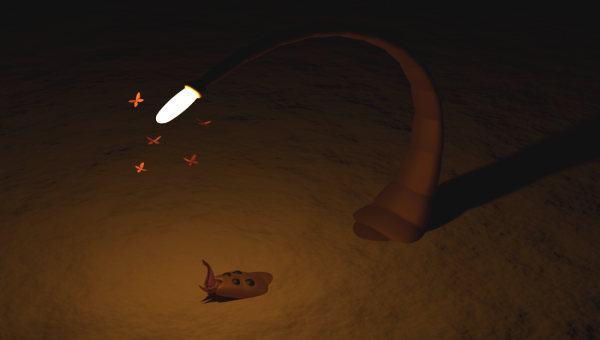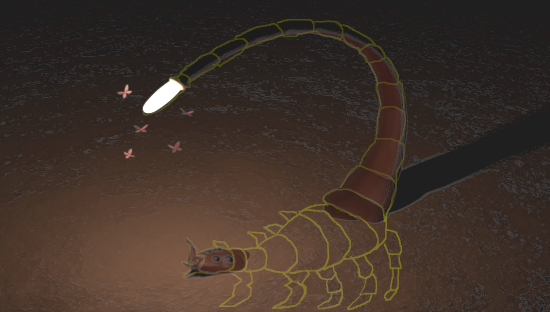BY LETTER
Lamptail
 Image from Andrew P. | |
| A lamptail attracting butterfly-like insectoids with its bioluminescent lure | |
The Lamptails evolved in the undergrowth of the skywracks, those kilometer-high trees that give this planet its name. They are found primarily in the dense coastal forests where the larger skywracks thrive, their vast shadows blocking most of the sun's light. Consequently, most species in the understory have been forced to adapt to near-constant darkness. While the lamptails defy easy categorization, they are most often likened by Terragens to a hybrid between a frog, a scorpion, and an anglerfish. These segmented creatures are generally of a dark brown hue, and the main body (excluding the tail) measures between 2.25 and 2.75 meters in length depending on sex.
Like all members of its clade, the Lamptails do not have noses, but instead take oxygen in through the mouth. This means that they are unable to eat and breathe simultaneously, but due to their homeworld's oxygen-rich atmosphere and their highly-efficient respiratory system, this is not an issue. As with most arthropod-equivalents on Trees, they have a rudimentary internal skeleton as well as an external carapace. Lamptails possess two pairs of eyes, and walk on ten feet, with their most distinctive attribute being the long, overhanging tail which stretches above their heads, ending in a bulb. Like many other creatures found in Trees' undergrowth, Lamptails utilize a form of bioluminescence which has been compared to the fireflies of Old Earth: in their case, the bulb of the tail acting as a source of light. Lamptains are passive hunters, with their natural light attracting all manner of insectoids and small flying organisms. Once these animals are drawn to lamptail's glow, its hooked, whip-like tongue swiftly snaps up the prey. One trait that appears to be unique to the lamptails is their ability to modulate their ocular reflectivity, thereby preventing their natural eyeshine from giving away their presence.
Females lamptails tend to glow brighter than the male counterparts, allowing them to signal potential mates from great distances. This also has the benefit of attracting more prey, and females of this species tend to grow larger. After depositing her egg sac, the female lamptail cares for her young on her own: as their offspring do not develop bioluminescence until after month after hatching, she allows them to partake of her captured prey by snapping their tongues at the insectoids that approach her. This allows them to refine their hunting ability, although the lamptail is a strict mother: the slowest of her young much either catch up with their siblings or face starvation.
 Image from Andrew P and Steve Bowers | |
| Diagram showing the subterranean portion of the lamptail shown in the previous image | |
Related Articles
Appears in Topics
Development Notes
Text by James Rogers
Initially published on 01 January 2025.
Initially published on 01 January 2025.






